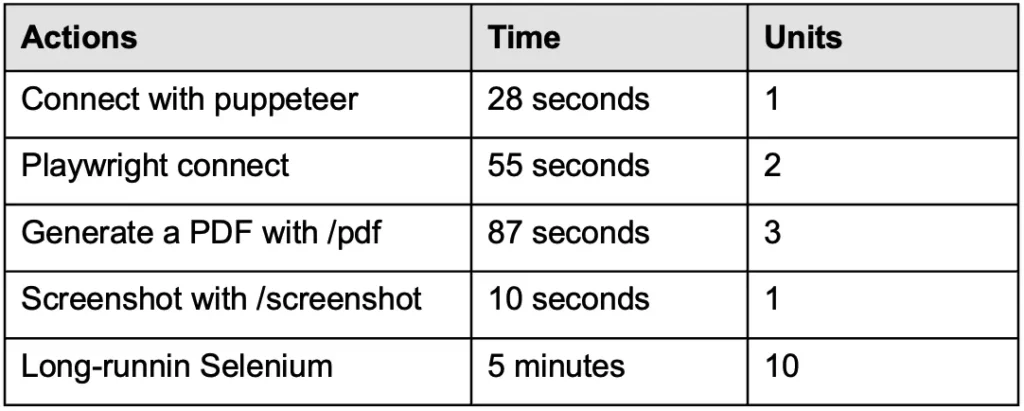Introducing Unit-based Pricing
Today we are introducing a new measure of consumption for the Browserless Subscription platform. We are calling it Unit-based pricing, and it replaces our previous Usage-based pricing. We are also switching from usage-based plans to monthly subscriptions, and introducing a 7 day-trial period!
Before anyone starts to sweat, let us assure you that there will be no changes to accounts on legacy plans. If you do want to switch over, we can help you with that!
What are the new plans?
We are keeping it simple. We have 2 self-serve plans on the Unit-based model for the number of units and pricing shown below, but if you have specific requirements, our Enterprise plan is your best option where we will provision the exact infrastructure you need based on a call we have with your team, contact us to get started!

Why the change?
We have spent a lot of time with customers trying to help them understand how much Browserless will cost. Over and over again we have seen that customers know how many Sessions they need, but equating that into time is much less predictable. The internet can also be fairly volatile – a website that took 5 seconds to load might suddenly take 20 or more. Units are closely equivalent to Sessions, so it made a lot more sense to us to transition to a Unit-based model and we think it will make things more predictable for customers.
Usage-based plans also led to less predictable Browserless costs for customers. Our new monthly subscriptions cost less per Session and allow customers to have more predictable monthly costs. If you go over your plan we now have Unit-based overages, so your service won’t just stop!
Last but not least, we want to offer a 7-day trial! This will help you try out our solution before committing.
What is a Unit?
A Unit is mostly equivalent to a Session. Each webpage you scrape, each PDF you generate, or each test browser you launch is a Session, and will be one Unit. If a Session is long-lived, every 30 seconds of that Session is a Unit; so a 75-second Session would be 3 Units. Here’s a quick chart to gauge what a Unit might look like:
Note: 98% of users' Sessions are less than 30 seconds

Best practices on Unit-based plans
It's important to be mindful of how many units you're consuming, especially when there are unexpected timeouts or errors, which can cause your browser to hang after your connection with the browser is unexpectedly terminated. Units will keep counting as long as that browser is alive, so it may end up using more units from your subscription than intended.
The best practice here is always to use try/catch blocks to ensure your browser is closed once you've finished using it, here's a complete tutorial on making your script bulletproof written by Joel Griffith.
As a safety measure, you can also specify a custom TTL of your browser by setting the &timeout flag to a number of milliseconds that your session will normally return in. The default timeout for connections is 15 minutes, i.e. 30 units, but if you're sure your browser should not take longer than something like 1 minute, you can specify the timeout to 60000, limiting browsers to consume a maximum of 2 units, even when they do hang.
Is anything else changing?
Along with this, you can now start a 7-day free trial or have a high-touch conversation with us to explore our Enterprise plan, which is specifically tailor-made to your infrastructure requirements. For that, you'll need to contact sales and let us know what you're trying to accomplish so we can set you up for success.
More questions? Talk to us!
If you have any additional questions, or you would like to switch your account to one of our new plans, please reach out. Thanks!
